How to Build a Screened-In Porch That Doesn’t End in Disaster
I’ve spent a lot of my life building things outdoors, and I can tell you, nothing transforms a house quite like a well-built screened porch. It’s more than just extra space; it’s a whole new way to live. It’s where you sip coffee without swatting mosquitoes, enjoy dinner on a warm night, or just sit and listen to the rain without getting wet. But honestly, I’ve also been called in to fix some real messes—sagging screens, wobbly walls, and leaky roofs that cause thousands in damage. These problems almost always start with bad planning and not really understanding the materials.
In this article
A good screened porch is a complete system. The foundation, the framing, the screening, and the roof all have to work in harmony. This isn’t just about stapling up some mesh. It’s about building a safe, durable extension of your home. So, this guide isn’t about throw pillows and string lights. We’re talking about the bones of the project, the stuff that really matters, so you can make smart choices whether you hire someone or bravely decide to tackle it yourself.
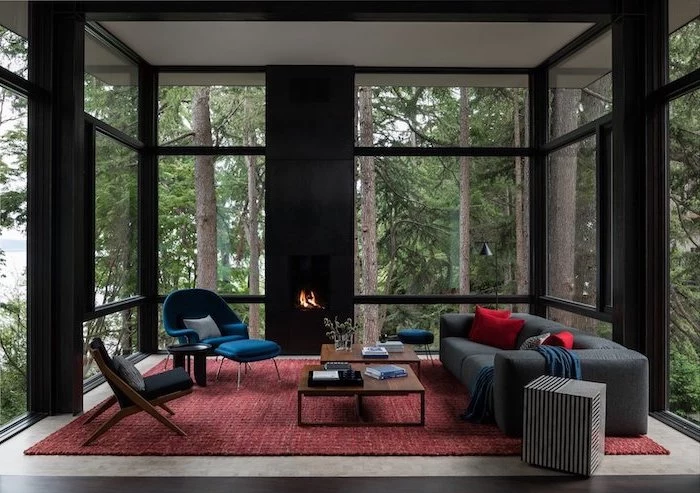
First Things First: Is This Project Even Worth It?
People always ask me about the cost versus the benefit. If you’re just thinking about resale value, yeah, a solid screened porch usually adds a nice bump to your home’s price. But the real return on investment is how you’ll use it every day. It’s that bug-free zone that lets you enjoy the outdoors without the downsides.
It’s the perfect middle ground. You get the fresh air and nature sounds while being protected from bugs and harsh sun. For families with kids or anyone who’s a mosquito magnet, it’s a total game-changer. In most places, it’s a three-season room, and in warmer climates, you might just live out there year-round.
But let’s be realistic. A standard screened porch is not a four-season sunroom. It’s not insulated and it doesn’t have heating or cooling. It’s going to be chilly in the winter. Trying to convert it into a fully enclosed room later is a massive undertaking that requires a different foundation, insulated windows, and a much bigger budget. Knowing this from the get-go saves a lot of disappointment.
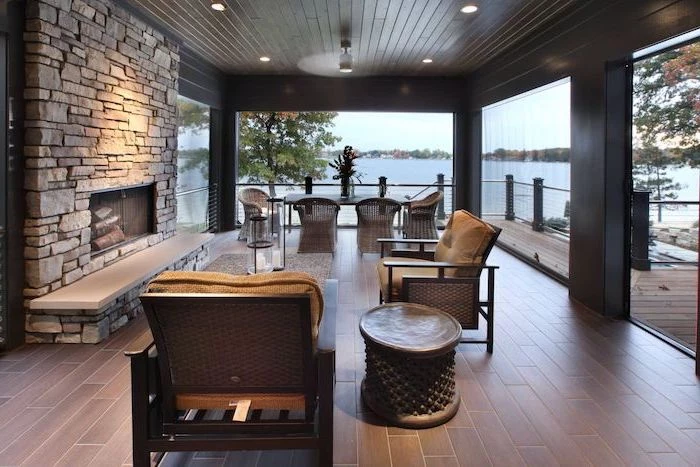
And the budget? It’s all over the map. Let’s break it down:
- The Budget-Friendly Conversion (around $3,000 – $7,000): This is for when you already have a structurally sound, covered porch or patio. You’re basically just building screen walls. The cost covers lumber for framing, screen materials, a new screen door, and maybe some paint or stain. A handy DIYer could knock this out in a couple of dedicated weekends.
- The Full Build (from $20,000 – $50,000+): This is starting from scratch. We’re talking about digging footings, pouring a concrete slab or building a deck foundation, framing walls, and building a brand-new roof that ties into your house. This is a major construction project. For a pro crew, this might take 2-4 weeks. For a DIYer… well, it could be your project for the entire summer.
The Structure: Get This Wrong and Nothing Else Matters
Before you even look at a roll of screen, you have to deal with the structure. This is non-negotiable. It’s all about safety and making sure your investment doesn’t fall apart in a few years.
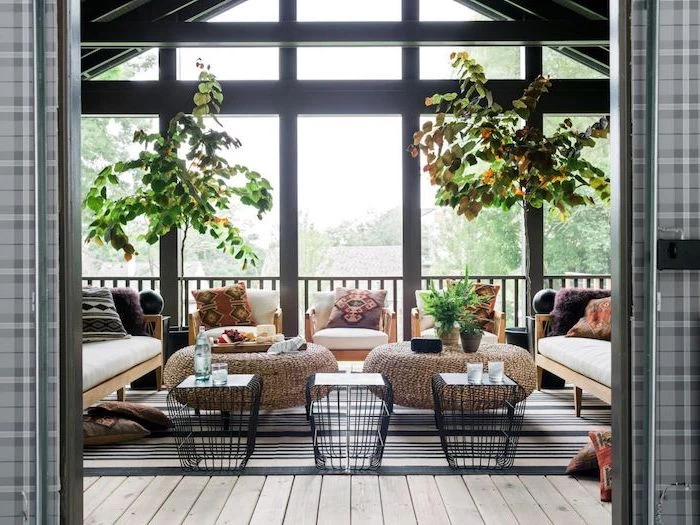
Got an Existing Deck? Do This 5-Minute Check.
Go outside right now and look under your deck. Are the support posts resting on proper concrete footings that go deep into the ground? Or are they just sitting on those pyramid-shaped concrete blocks on the grass? If they’re just on blocks, you can’t build a roof on it. Period. The structure will shift with the frost and literally pull your new porch apart.
Next, check the ledger board—that’s the piece of wood connecting the deck to your house. It MUST be attached with heavy-duty structural screws or lag bolts, never just nails. I once had to fix a porch that was peeling away from the house, threatening to collapse. The fix cost the homeowner over $5,000, all because the original builder tried to save about $50 by using nails instead of the right bolts. Also, make sure there’s metal flashing tucked behind that board to keep water out of your house’s frame.

If you have any doubts at all, it is worth every penny to pay a structural engineer for an inspection. It’ll probably cost you between $300 and $700 and could save you from a catastrophe.
Building a New Frame from Scratch
Building new means you can do it right. You’ll dig and pour concrete piers that go below your local frost line. The frame itself should be built with pressure-treated lumber, especially anywhere it’s close to the ground. Heads up: always wear gloves and a dust mask when cutting this stuff, and never, ever burn the scraps—the fumes are toxic.
The walls are framed like house walls, with studs usually spaced 16 or 24 inches apart. I personally prefer 16-inch spacing because it creates a much sturdier wall and keeps your screen panels at a manageable width. Tying the new roof into your existing house roof is tricky. A simple shed roof is the most DIY-friendly, but this is one area where I often tell people to hire a professional roofer for a day. A leak can cause damage you won’t find for years.
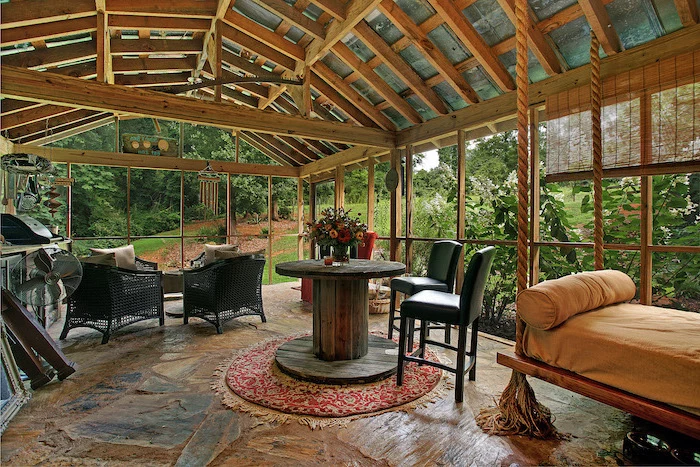
Oh, and here’s a huge time-saving tip: pre-paint or pre-stain all of your lumber on sawhorses before you assemble everything. It is ten times faster than trying to do it once the porch is built.
Choosing Your Screen: A Surprisingly Big Deal
Alright, with a solid frame in place, we can talk about the fun part. The screen you choose affects the look, durability, and feel of your porch. There’s no single “best” option—it’s about what’s right for you.
- Standard Fiberglass Screen: This is the default choice. It’s cheap (maybe $0.25 per square foot), flexible, and easy to find at any hardware store. Pro tip: always get the charcoal color, not gray. Charcoal absorbs light and you can see right through it, while gray reflects light and creates glare. Its weakness? It’s not very tough. Pet claws or a stray branch will tear it easily.
- Aluminum Screen: A step up in strength from fiberglass. The downside is that while it doesn’t tear, it dents and creases permanently. Lean on it once and you’ll have a permanent mark. It’s a decent mid-range option (around $0.50/sq ft) if you don’t have pets or kids who play rough.
- Pet-Resistant Screen: If you have a dog or a cat, just get this. Don’t even think about the others. It’s a super-strong, vinyl-coated polyester that can stand up to claws and rambunctious pups. The trade-off is slightly less visibility and airflow, and a higher cost (often $1.25-$1.75/sq ft). But saving yourself from constant repairs? Priceless. You’ll likely need to order this from a specialty supplier online or a dedicated window and screen shop.
- High-Visibility or ‘Invisible’ Screen: Made from super-fine fiberglass threads, this stuff offers an incredibly clear view. It really does feel like there’s nothing there. But… it is the most fragile of the bunch and the most expensive of the fiberglass options. This is for a quiet, protected porch where the view is everything.
- Solar Screen: If your porch gets blasted with afternoon sun, this is your hero. It’s a dense screen that can block up to 90% of the sun’s heat before it even enters the porch, making the space way more comfortable. It also doubles as a privacy screen during the day. The catch is that it darkens the porch and the adjoining rooms of your house quite a bit.
And how do you hold the screen in place? The modern, professional standard is a Spline System. Forget staples. With a spline system, your wood frame has a groove cut into it. You lay the screen over the groove and use a cheap little roller tool to press a vinyl cord (the spline) into the channel, locking the screen in place. The result is a perfectly tight, clean finish. Best of all, if a panel gets damaged, you just pull out the old spline and roll in a new piece in minutes.

How to Install Screens (The Right Way)
Let’s assume you’re using the spline system, which you absolutely should. Here’s a quick rundown of the gear you’ll need, which you can find at Home Depot or online:
- The screen material of your choice
- Spline (make sure to get the right diameter for your groove!)
- A spline roller tool (it’s about $10 and worth every penny)
- A sharp utility knife with plenty of extra blades
First, you need that groove in your frame. This is the step everyone asks about. It’s easy: you use a router with a straight bit (usually 1/8-inch or 3/16-inch, depending on your spline size). Set the depth to about 1/4-inch and carefully rout a groove around the inside perimeter of each screen opening. Do this before you paint for the cleanest result.
Now, to install. Cut a piece of screen a few inches bigger than the opening. Start at the top. Use the roller tool to gently press the screen into the groove for a few inches, then press the spline in on top of it. Work your way across the top edge.
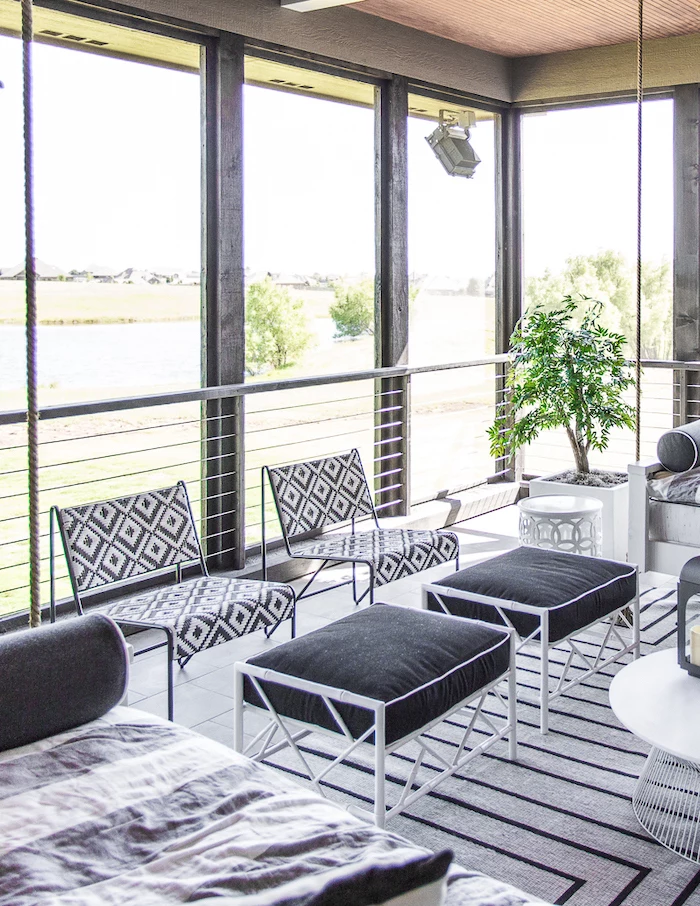
Next, do one of the vertical sides. Here’s the key: do not pull the screen tight with your hands. This is the number one mistake and it creates weird, ugly ripples. Just let the screen hang, and let the roller tool create the tension as you push the spline into the groove. Once one side is done, move to the bottom. As you roll the spline along the bottom, use your free hand to apply gentle downward pressure in the middle of the screen panel. This creates a slight bow. When you do the final, fourth side, that bow will pull out, leaving the screen as tight as a drum.
Once all four sides are in, grab your utility knife. With a fresh, sharp blade, hold it at a low angle and trim the excess screen right against the outer edge of the spline. A clean, professional look.
A Final Word on Safety
I have to say it one more time. Safety is not a shortcut. It’s everything.
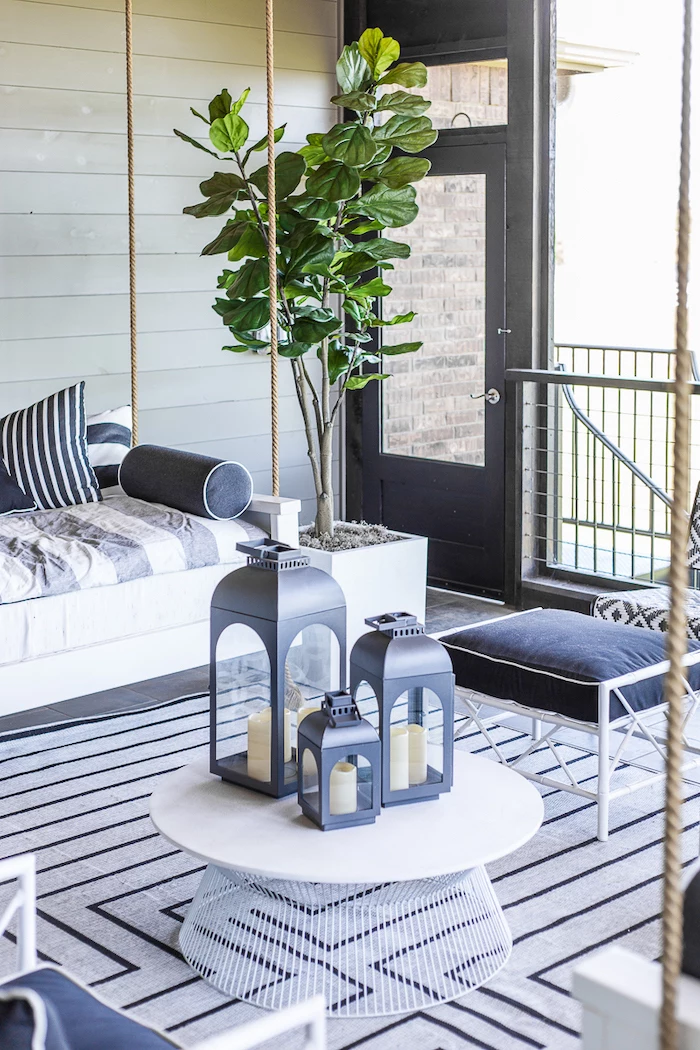
If you need outlets, lights, or a fan, hire a licensed electrician. Outdoor wiring is serious business, and a mistake can lead to fire or electrocution. They’ll make sure everything is GFCI-protected, which is required by code and can literally save your life.
And please, don’t put a roof on a structure that can’t handle it. A collapse is a nightmare you don’t want to live through. Be smart, plan ahead, and if you’re ever in doubt, call a pro.
Building a screened porch is an incredibly satisfying project. When you take your time, use the right techniques, and respect the process, you’re not just adding value to your house—you’re building a space that will bring you and your family joy for years to come.
Inspirational Gallery
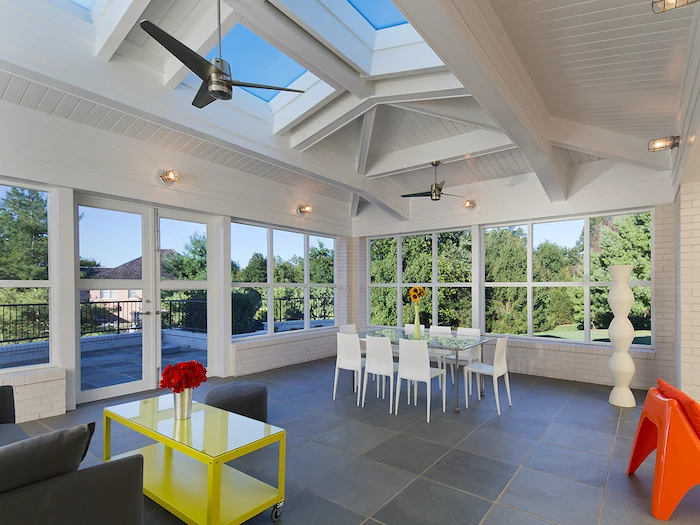
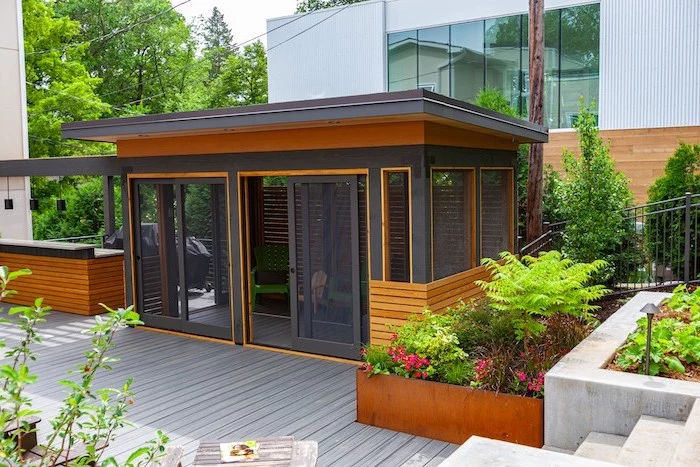
- A drum-tight, flawless screen finish.
- No visible staples or rough edges.
- Simplified repairs if a panel gets damaged.
The secret? Look into spline screening systems. Brands like Screen Tight or SCREENEZE use a vinyl cap or channel system that hides fasteners and holds the screen taut, offering a professional look that’s much more durable than simple stapling.
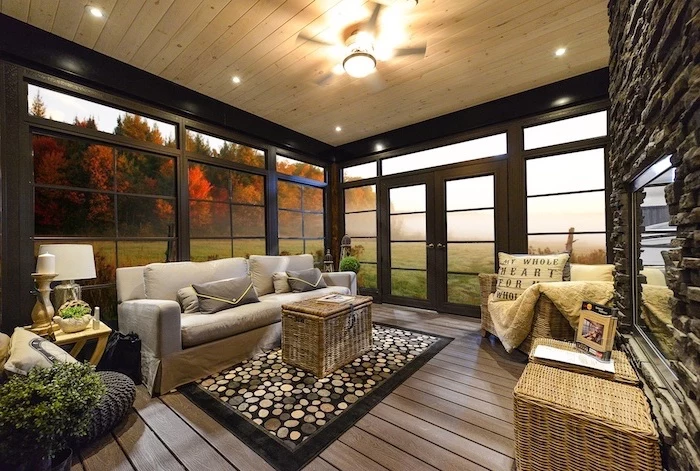
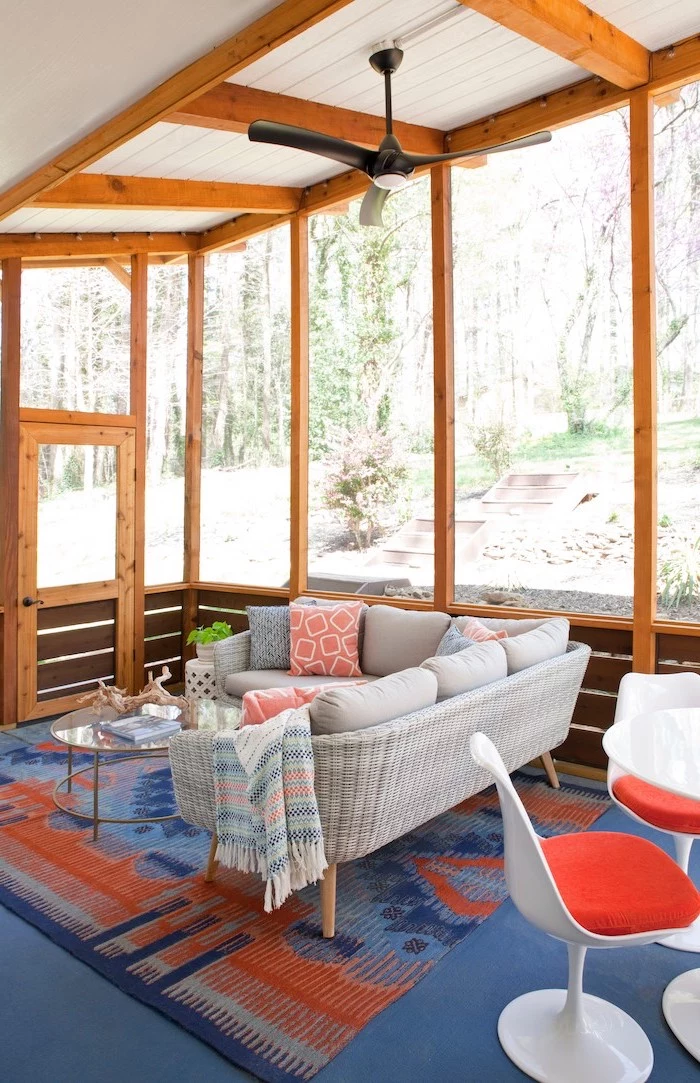
What about electrical outlets?
Don’t treat them as an afterthought. Integrating electrical into your porch plan from the start is a game-changer. Plan for at least one GFCI-protected outlet on each wall for lamps, device chargers, or even a small outdoor-rated space heater. And if there’s one non-negotiable addition, it’s a ceiling box rated for a fan. The air circulation will make the space comfortable on the hottest, most stagnant days.
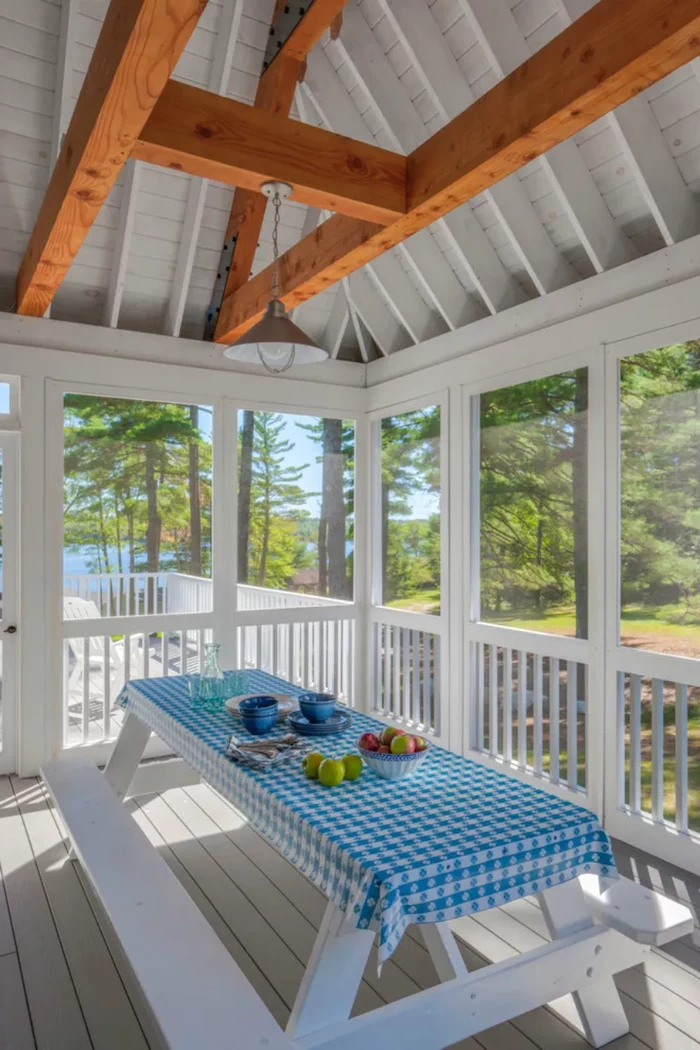
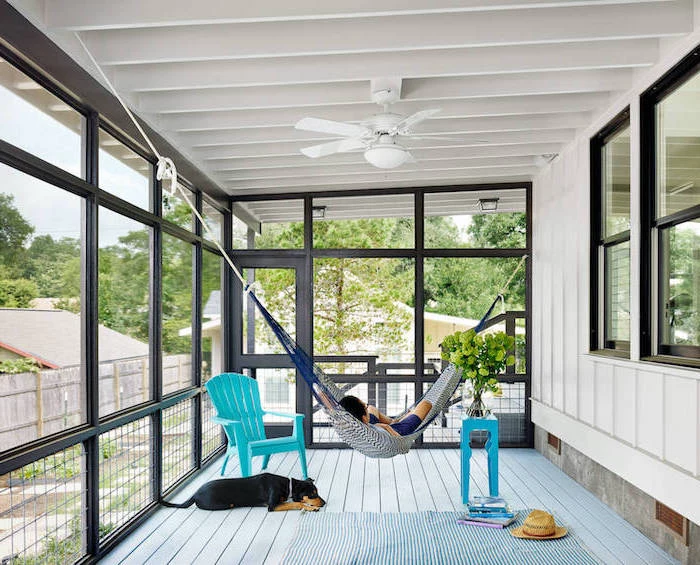
A 2023 Remodeling Cost vs. Value Report found that a backyard patio or deck project can recoup over 50% of its cost upon resale, but a screened porch often performs even better, with some estimates reaching up to 80% ROI.
This high return isn’t just about square footage; it’s about adding highly usable, desirable living space. Buyers perceive it as a significant lifestyle upgrade, bridging the gap between the house and the yard.
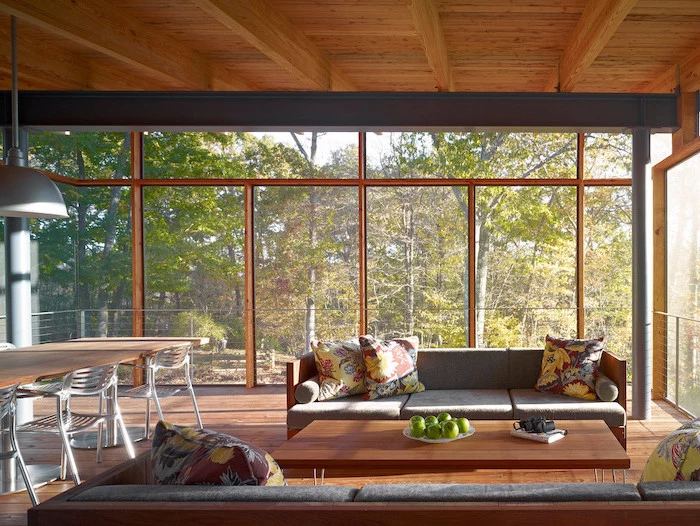
Pressure-Treated Pine: The budget-friendly workhorse. It’s chemically treated to resist rot and insects, but can be prone to warping or cracking if not properly sealed and maintained.
Cedar or Redwood: The premium choice. These woods contain natural oils (tannins) that make them inherently resistant to decay and bugs. They offer a rich, beautiful finish but come at a significantly higher price point. Choose Cedar for a classic, durable structure that weathers gracefully.
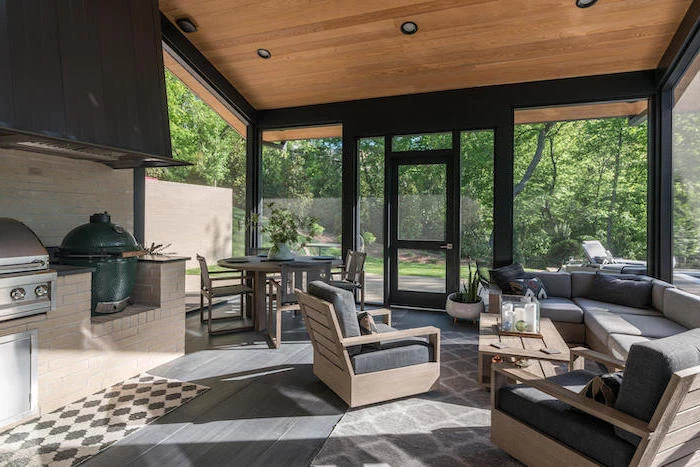
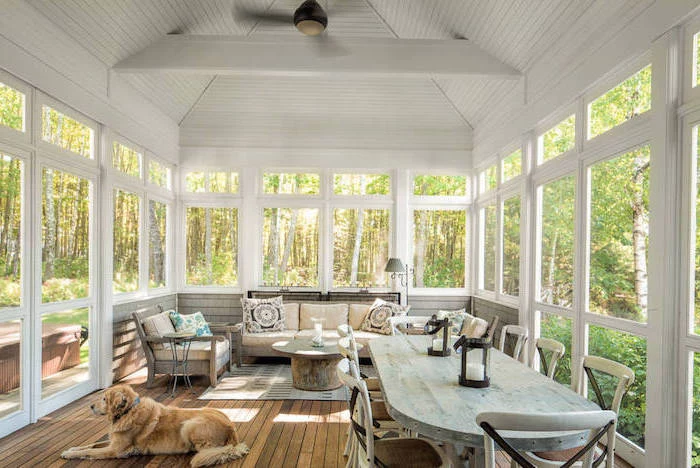
One of the most charming traditions for porch ceilings, especially in the American South, is to paint them a soft blue-green, often called ‘Haint Blue.’ Historically, it was believed to ward off spirits (‘haints’), but it also has a practical effect: some believe it fools insects into thinking it’s the sky, discouraging them from nesting. Regardless of folklore, it creates a wonderfully serene, airy atmosphere.
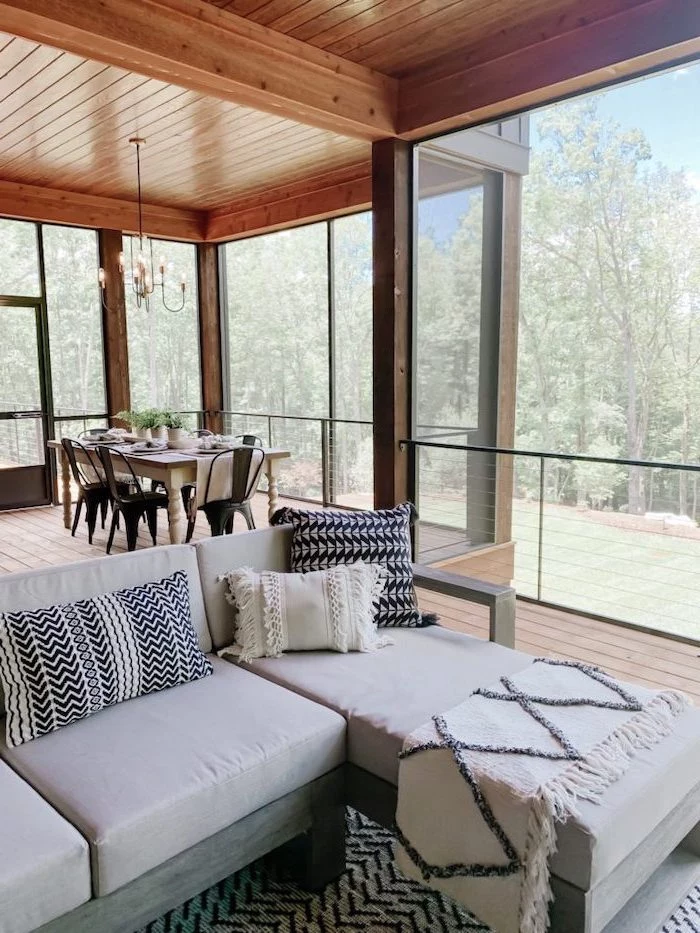
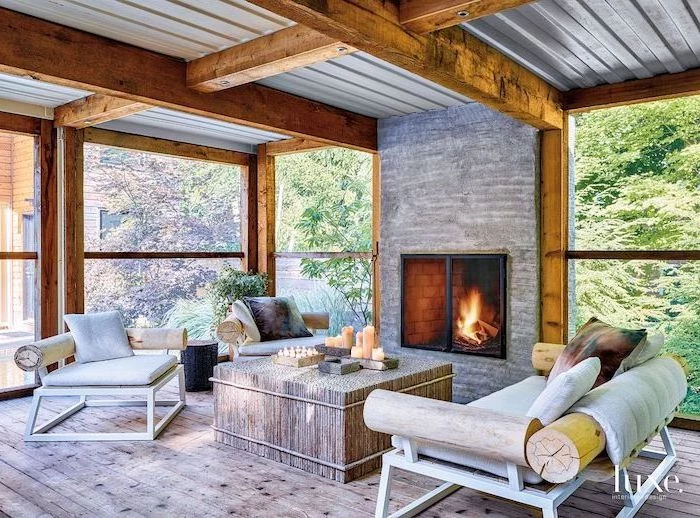
Important: Don’t forget the floor pitch! Your porch floor, even though covered, must have a slight slope away from the house—about a quarter-inch drop for every foot of run. This is non-negotiable. It ensures that any wind-blown rain, melting snow, or water from cleaning the floor drains away properly instead of pooling against your home’s foundation.
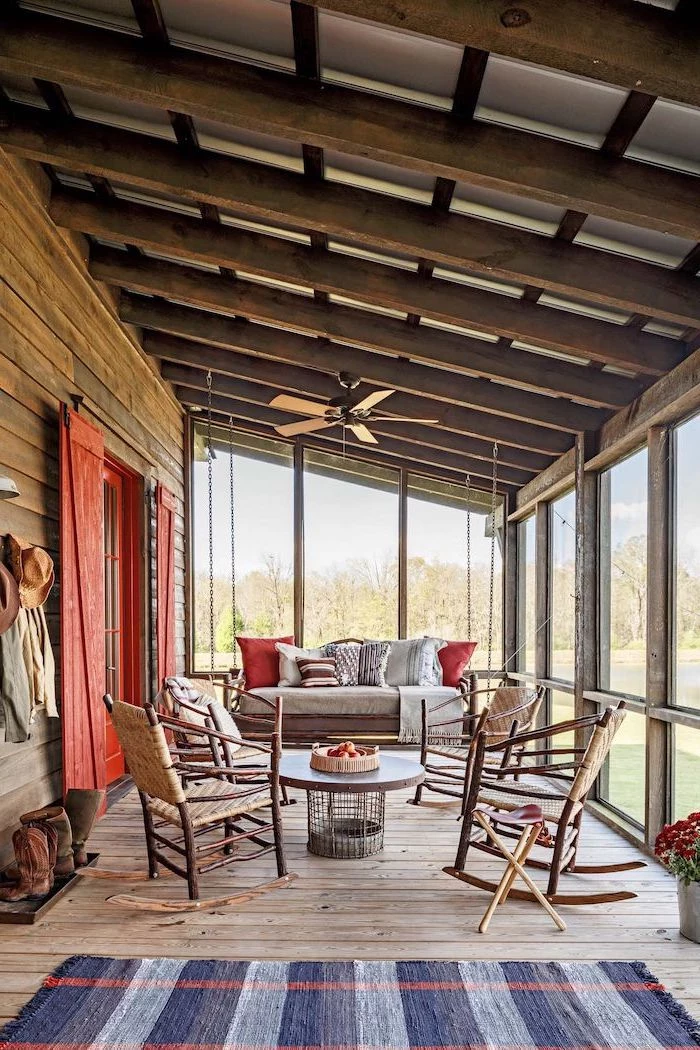
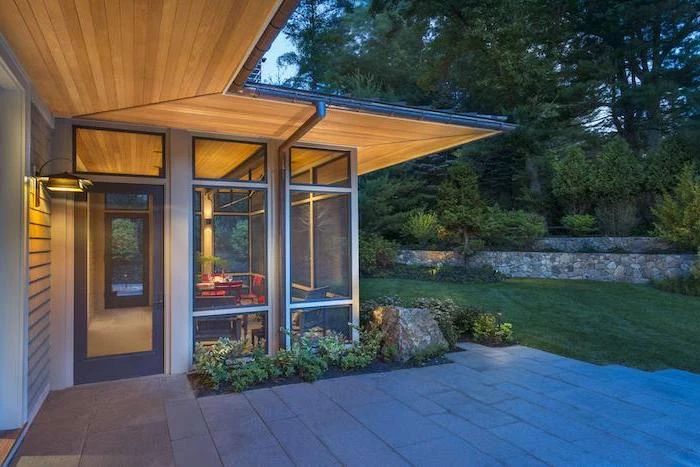
- Fiberglass Screen: The standard choice. It’s affordable, flexible, and doesn’t crease easily. It’s perfect for most applications, but can be torn by pets or sharp objects.
- Aluminum Screen: Offers a crisper, more rigid finish and won’t sag over time. It’s more durable than fiberglass against general wear but can be dented or creased permanently.
- Pet-Resistant Screen: If you have cats or dogs, this is a must. Brands like Phifer PetScreen are made of vinyl-coated polyester, which is 7 times stronger than standard fiberglass and resists damage from claws.
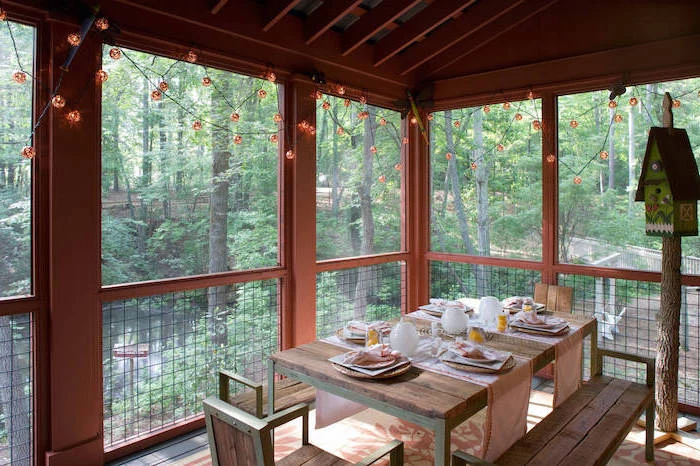
The average mosquito can detect human breath from over 100 feet away.
This is why the integrity of your screen is paramount. A tiny tear or a gap between the screen and the frame is an open invitation. When installing, ensure every inch is secure. For a truly bug-proof seal, spline systems are far superior to staples, which can create puckers and small openings over time.
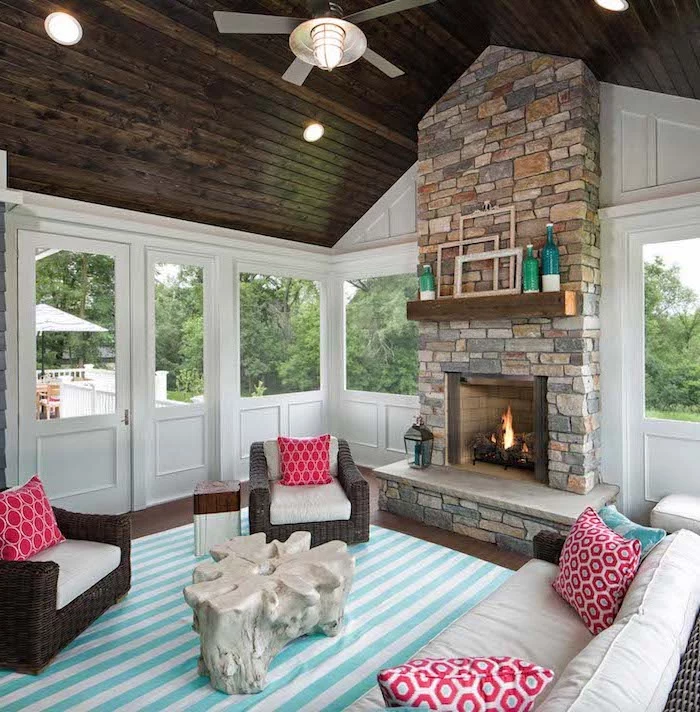
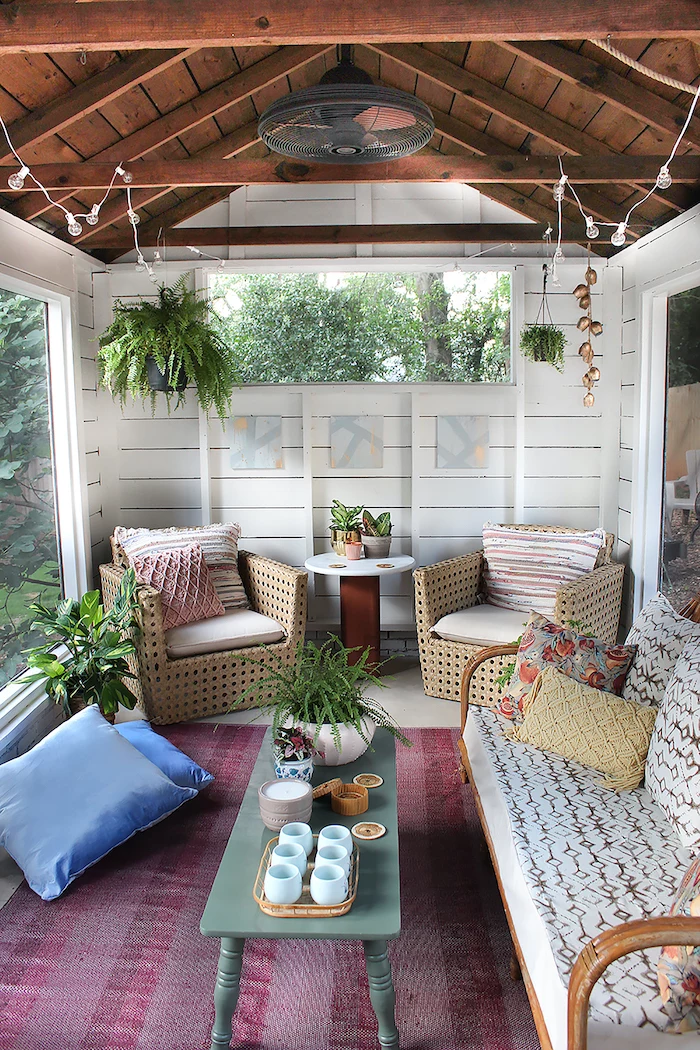
The knee wall—the solid half-wall at the bottom of the screen panels—is a key design element. Matching its material to your home’s exterior (like siding or brick veneer) creates a seamless, integrated look. Alternatively, using a contrasting material like beadboard paneling can define the porch as a distinct ‘room’ with its own character.
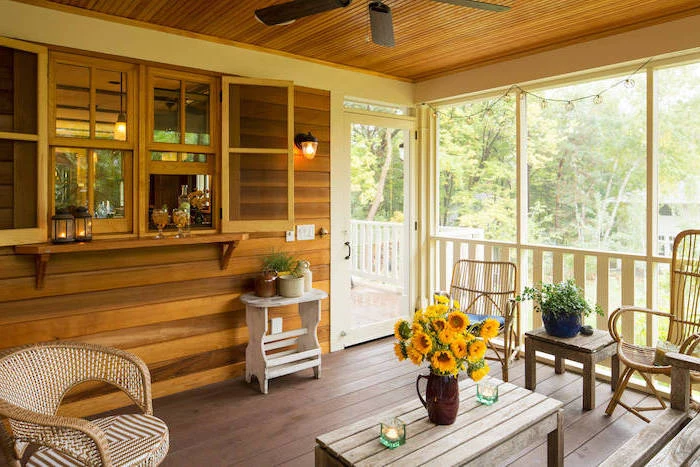
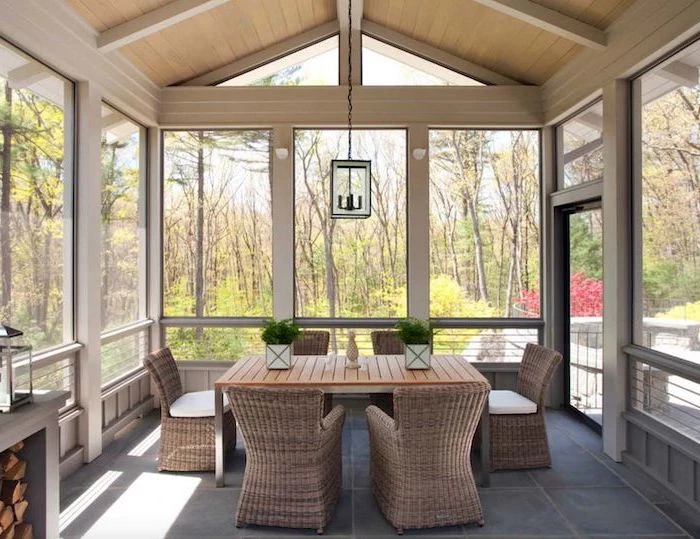
Can I have a fireplace on my screened porch?
Absolutely, and it creates an incredible three-season ambiance. However, it requires serious planning. You’ll need a proper non-combustible foundation for the fireplace structure, and the flooring immediately around it must be masonry, tile, or stone. Most importantly, consult with a professional to ensure the chimney and ventilation meet all local fire codes for safety.
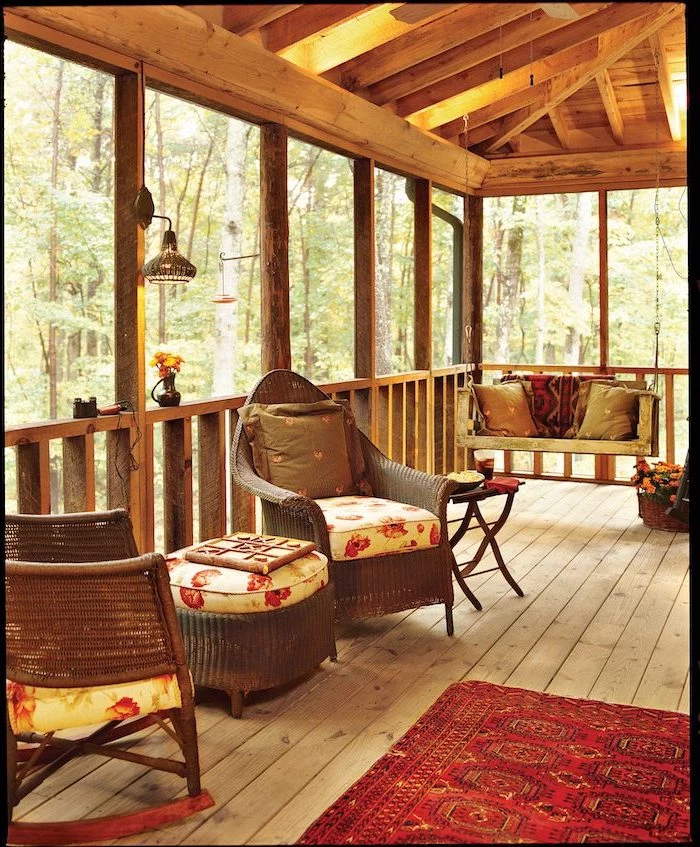
Thinking about your flooring early on is crucial as it impacts the foundation plan. Your main choices are:
- Wood or Composite Decking: Creates a classic, warm look. Use composite brands like Trex or TimberTech for minimal maintenance, or natural cedar for authentic beauty. Ensure gaps are minimal to prevent things from falling through.
- Poured Concrete Slab: A durable and modern option. It can be stained, stamped, or left plain. It’s easy to clean but requires a more involved foundation.
- Outdoor Tile or Pavers: Offers endless design possibilities and is extremely durable. It requires a concrete slab base for installation.
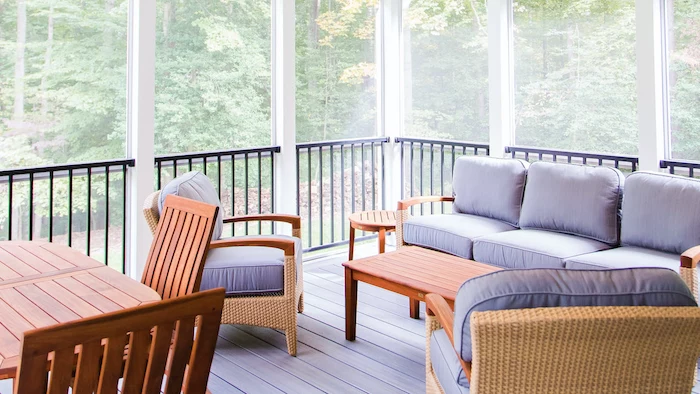
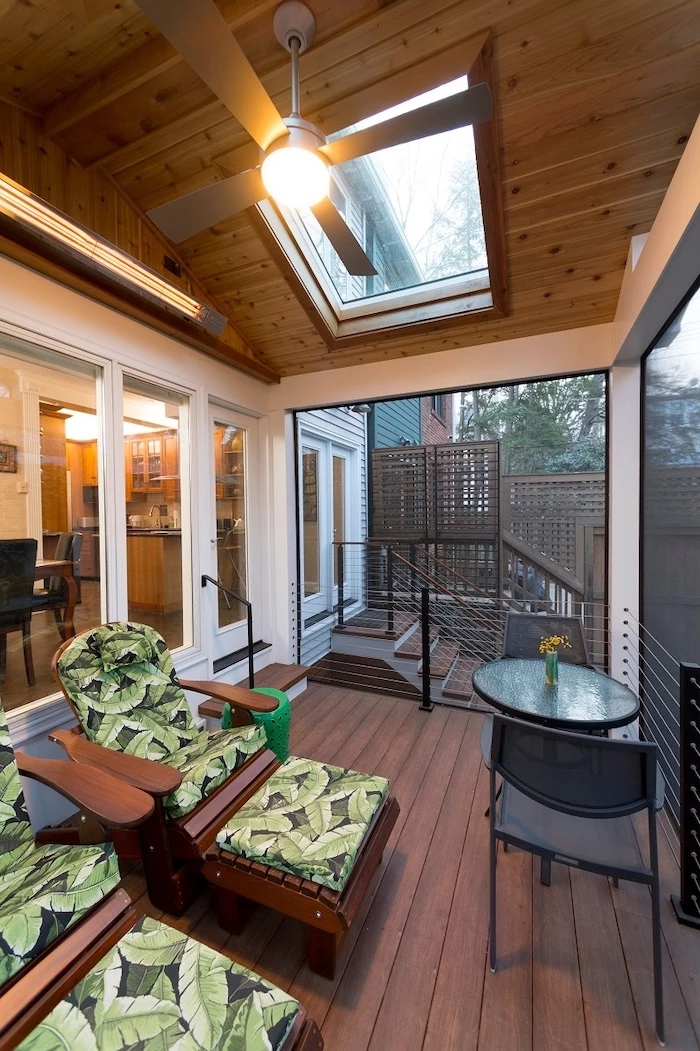
Ceiling Style Tip: For a classic, coastal, or cottage feel, nothing beats a beadboard ceiling painted in a crisp white or a pale ‘haint blue’. If your home is more rustic or a modern farmhouse style, consider leaving the roof rafters and decking exposed and staining them for a dramatic, vaulted effect that draws the eye upward.
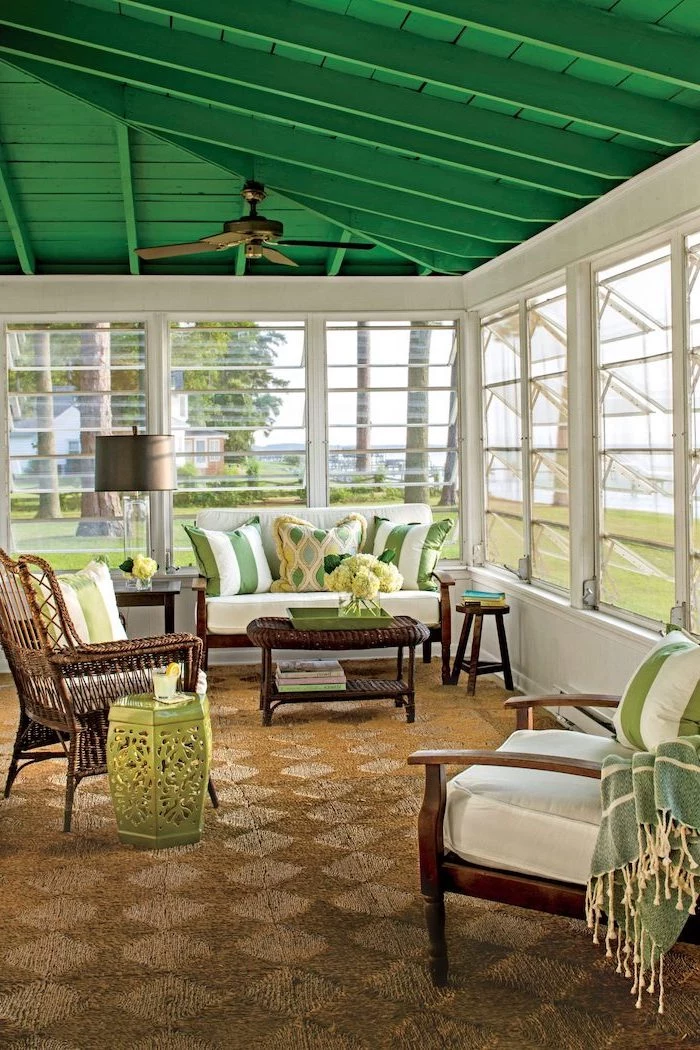
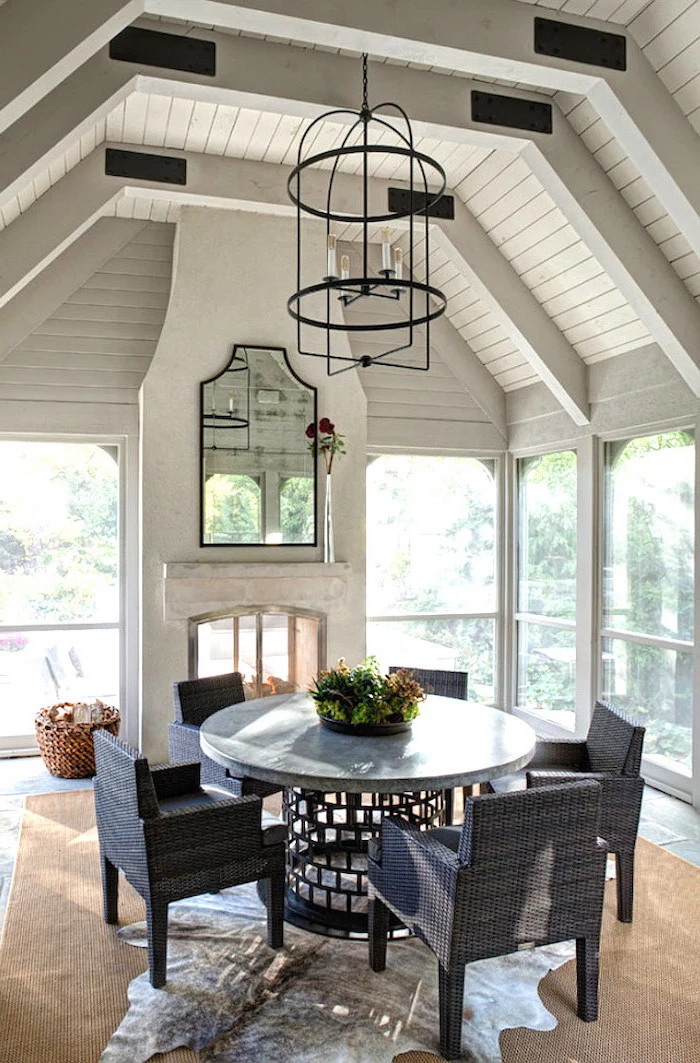
It may seem like a minor detail, but a high-quality, self-closing screen door is worth every penny. It’s the single biggest defense against letting bugs in.
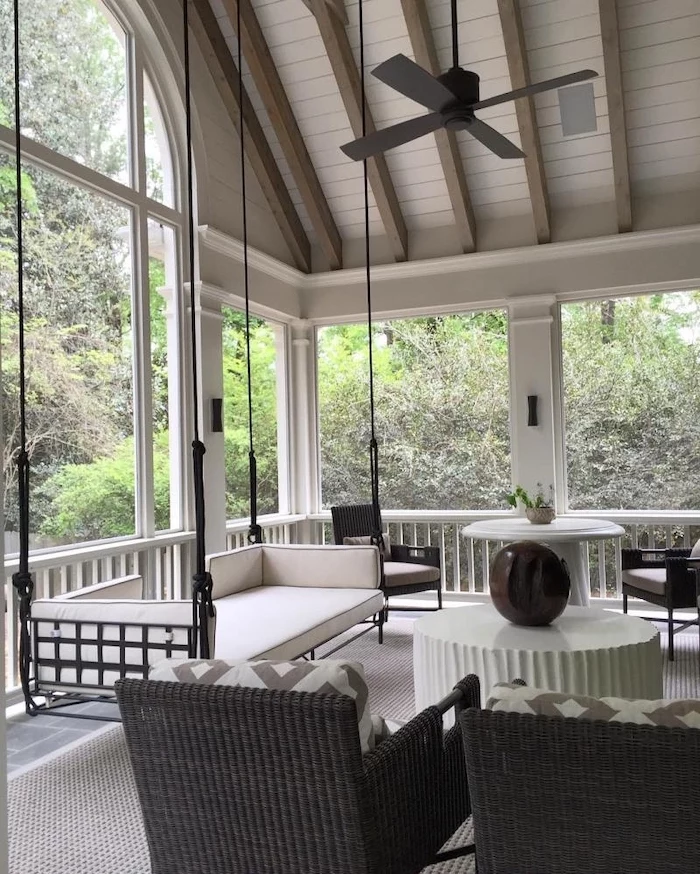
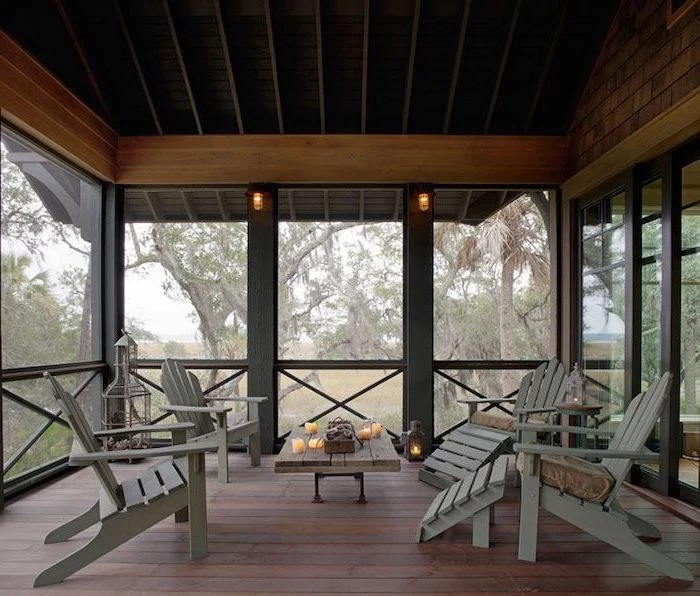
Before a single board is cut, check with your local building department. A screened porch with a permanent roof is almost always considered a structural addition and will require a permit. This process ensures your plans meet safety standards for snow load, wind resistance, and foundation depth for your specific region.
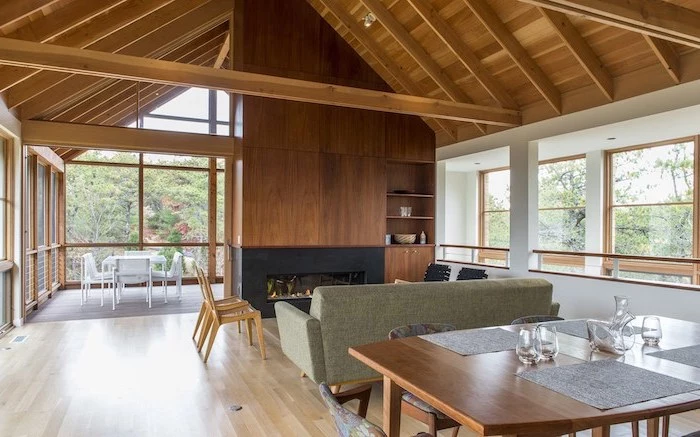
- Creates a completely unobstructed view when you want it.
- Protects furniture from pollen and dust when closed.
- Turns your porch into a more secure space at the touch of a button.
The solution? Motorized retractable screens. Systems from companies like Phantom Screens are a high-end option that offers ultimate flexibility, allowing you to have a completely open-air porch or a fully screened-in one on demand.
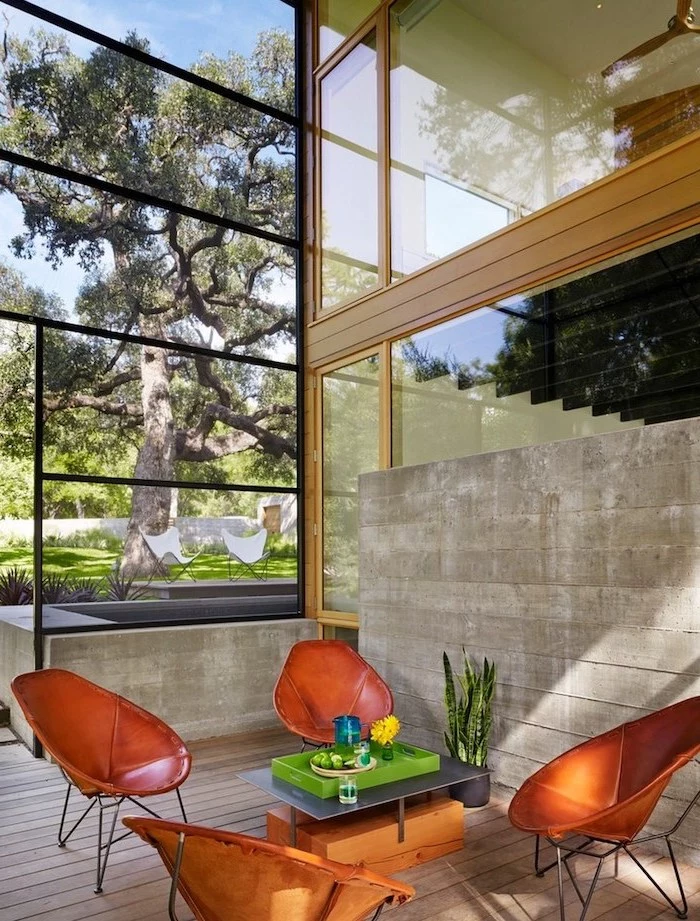
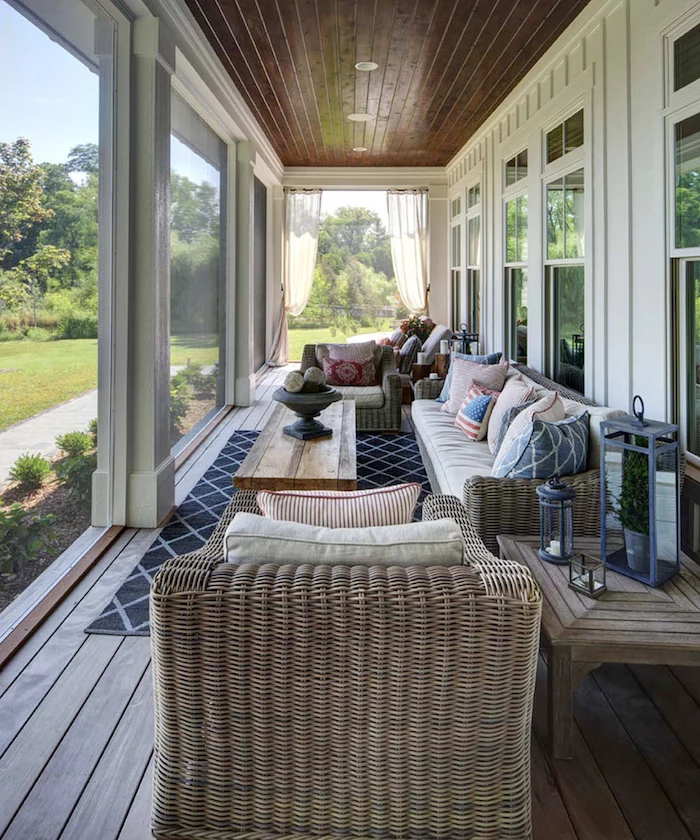
The Solar Screen Advantage: If your porch will be in direct, harsh sunlight, standard screens won’t do much to block heat. Consider a solar screen, like Phifer’s SunTex. These specialty screens are designed to absorb and dissipate up to 90% of the sun’s heat and glare before it reaches the porch, keeping the space significantly cooler and more comfortable.
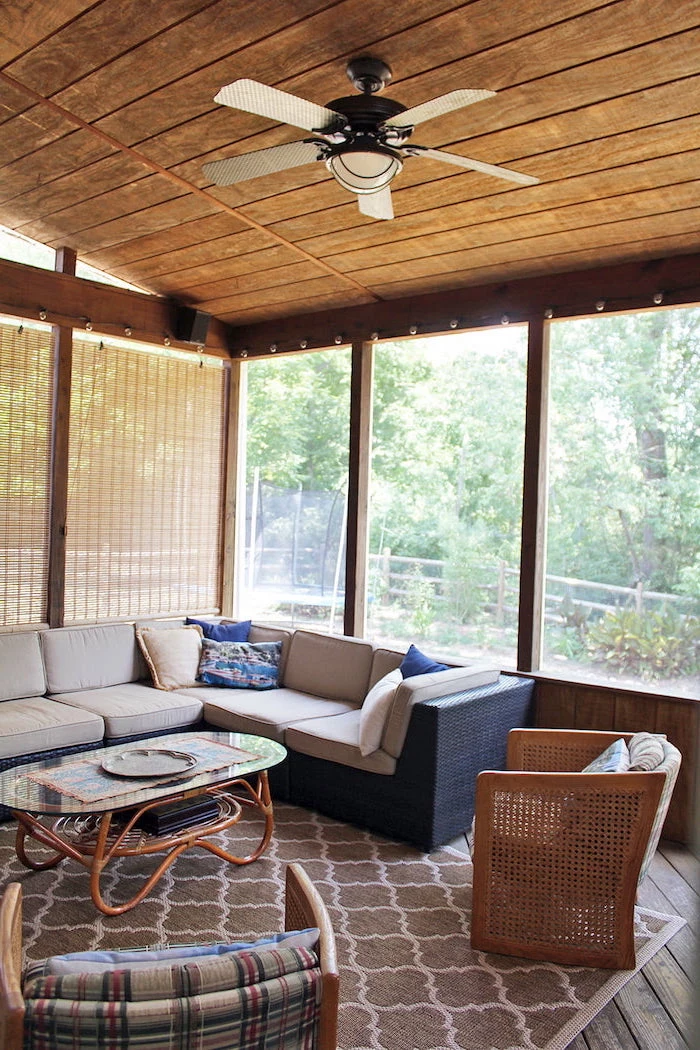
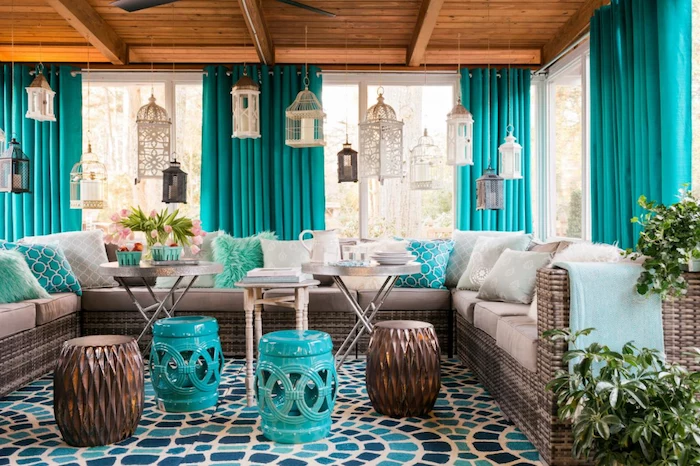
How do I screen the space underneath the floor?
It’s a step many DIYers miss. Insects love the dark, damp space under a porch. To block them, attach screen material to the underside of your floor joists before you install the deck boards. It’s an inexpensive, invisible solution that prevents pests from crawling up through the gaps in your flooring.
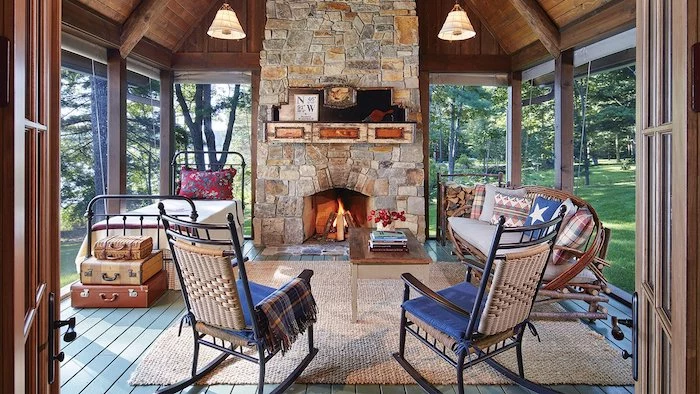
Lighting can completely transform the mood of your porch at night. Think in layers:
- Ambient: A central ceiling fan with a light kit provides general, diffused illumination.
- Task: A well-placed floor lamp or wall sconce is perfect for a reading corner.
- Accent: Use small, outdoor-rated spotlights to highlight plants or architectural features.
Always use dimmers to adjust the mood from bright and social to low and relaxing.
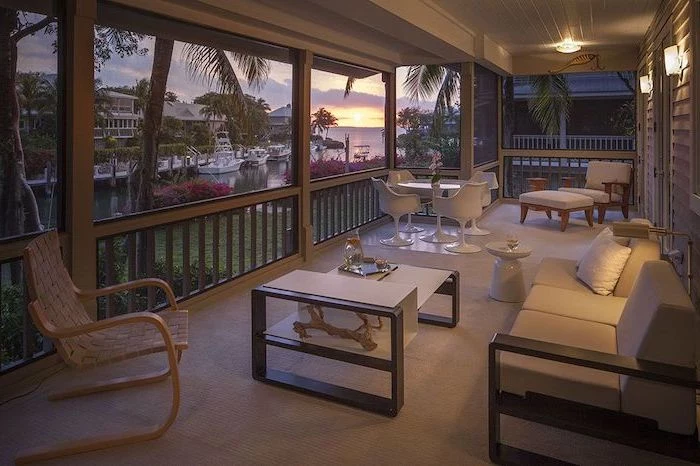
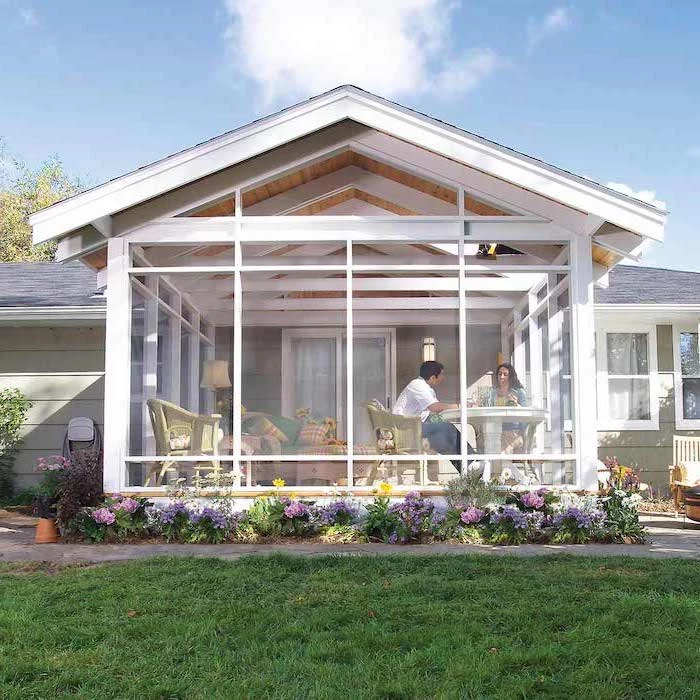
According to the American Lighting Association, a ceiling fan can make a space feel up to 8°F cooler in the summer.
This is due to the wind chill effect. For a screened porch, this can be the difference between a stuffy, unusable space and a comfortable retreat on a hot afternoon. Choose an outdoor-rated model to withstand humidity and moisture.
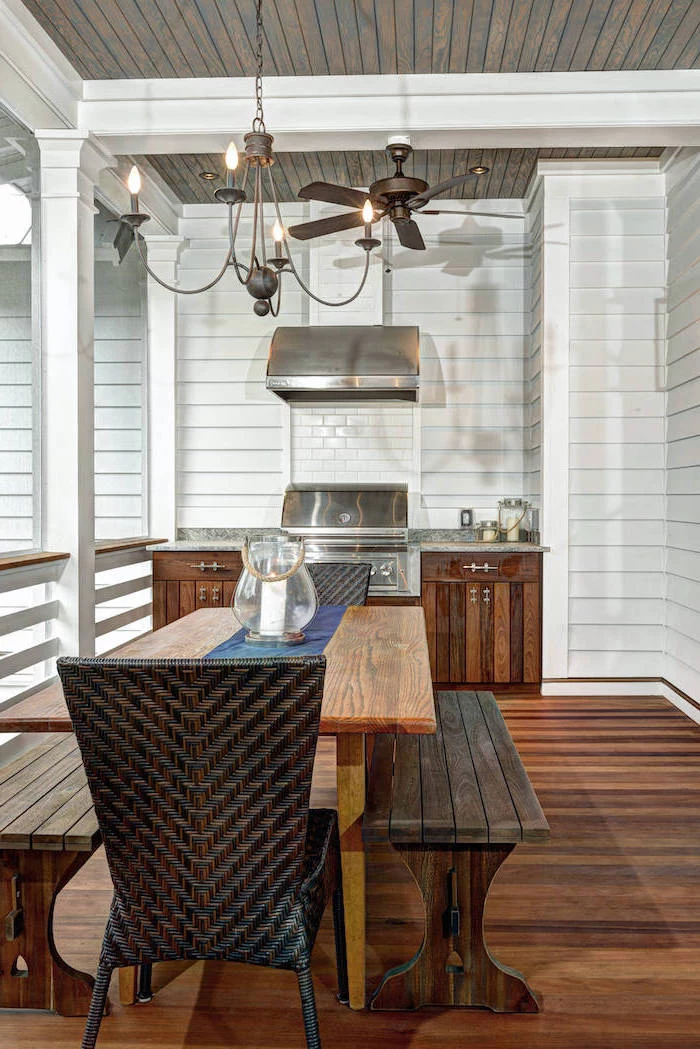
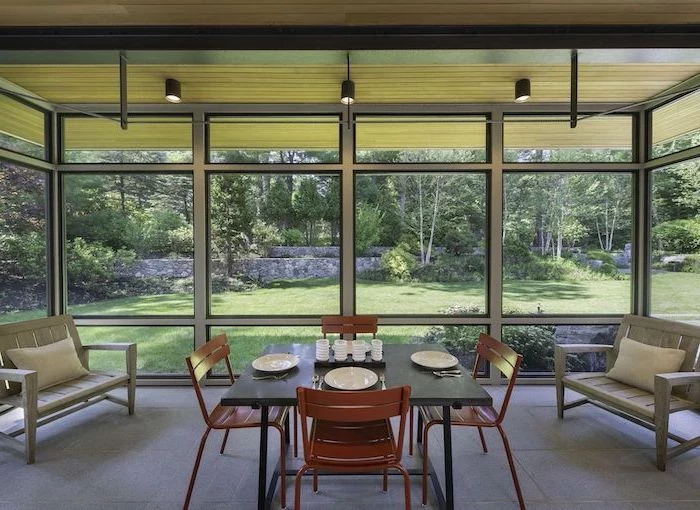
Common Mistake: Choosing furniture that’s too big or too small. Before you build, map out your intended furniture layout with tape on your lawn. Will your dream dining table leave enough room to walk around? Does that oversized sectional block the door? Visualizing the space with its intended contents prevents costly layout regrets.
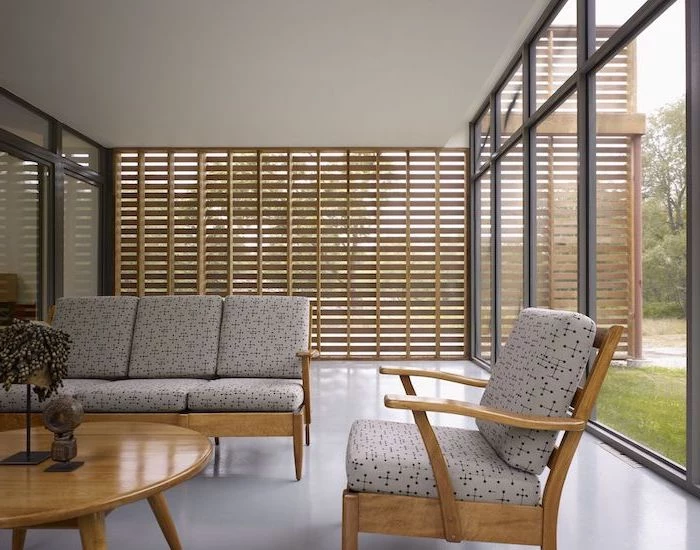

Gutter Integration is Key: A porch roof without a gutter system is a recipe for disaster. It will dump sheets of water right next to your new foundation, potentially causing erosion and water issues. Ensure your plan includes integrating gutters that tie into your home’s existing drainage system to channel water away effectively.
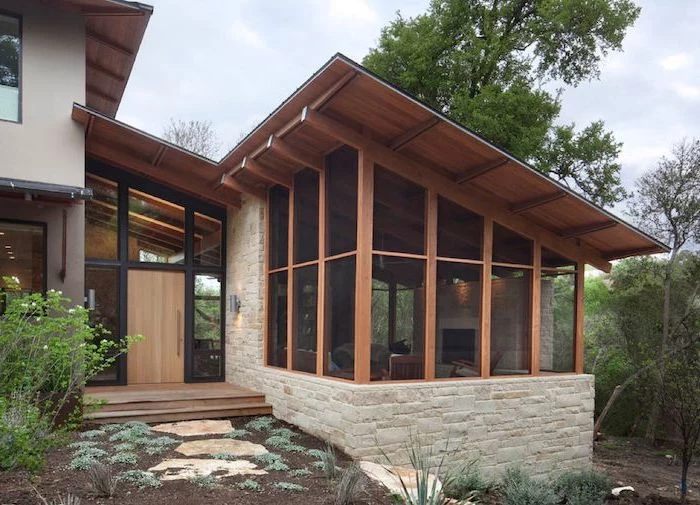
For a clean, modern aesthetic that feels connected to the landscape, consider using large-format screen panels with minimal framing. Black aluminum frames paired with a high-transparency screen material like Phifer’s BetterVue can create an almost-invisible barrier, maximizing your views and making the space feel larger.

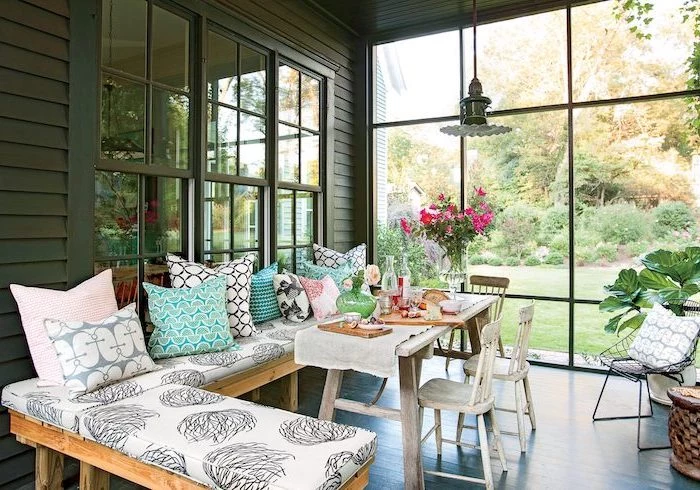
- An outdoor rug to define the seating area.
- Weather-resistant curtains for softness, privacy, and sun protection.
- Potted plants and climbing vines to blur the line between the porch and the garden.
These finishing touches are what transform a well-built structure into a true outdoor room. They add color, texture, and personality, making the space feel like a natural extension of your indoor living areas.
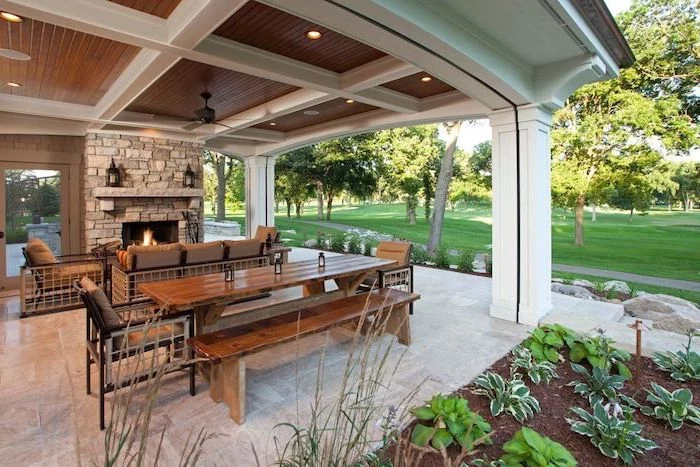

Is a composite deck floor worth the extra cost?
While the upfront cost is higher than pressure-treated wood, composites like Trex, TimberTech, or Azek pay you back in maintenance. They won’t splinter, warp, or rot, and you’ll never have to spend a weekend staining or sealing them. A simple cleaning with soap and water is all they need. Over the life of the porch, the time and money saved on upkeep can make it a very smart investment.
Your porch door will be one of the most used doors in your house. Choose a sturdy, high-quality aluminum or vinyl storm door with a durable closing mechanism and a secure latch. A flimsy wooden door will warp and stick with changes in humidity.










